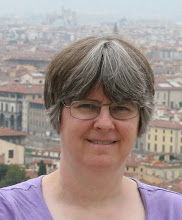Back from Italy
.jpg) I have over 1600 photos to sort through to select the best ones to show, and that's going to take some time, but here's a start. This one I've titled "The Art Critics." As would be expected from a trip to Italy which focused on visiting family and taking a seminar in Florence called "Art and Cultural Transformation in the Renaissance," a lot of my photos are portraits or group candids of family members, reproductions of art, and documentary travel photos, not many of which would be worth sharing on this blog (however I will be putting together an online photo album of a selection of my trip photos to show friends and family who are interested in seeing them and will announce its availability here). But there are a few when I was consciously trying to make art myself instead of just looking at it, and those (when successful) I'll be showcasing here over the coming days or weeks.
I have over 1600 photos to sort through to select the best ones to show, and that's going to take some time, but here's a start. This one I've titled "The Art Critics." As would be expected from a trip to Italy which focused on visiting family and taking a seminar in Florence called "Art and Cultural Transformation in the Renaissance," a lot of my photos are portraits or group candids of family members, reproductions of art, and documentary travel photos, not many of which would be worth sharing on this blog (however I will be putting together an online photo album of a selection of my trip photos to show friends and family who are interested in seeing them and will announce its availability here). But there are a few when I was consciously trying to make art myself instead of just looking at it, and those (when successful) I'll be showcasing here over the coming days or weeks.
Sometimes more interesting photographs come from photographing not the "main attraction" (e.g., the art in a museum or cathedral) but rather something you see when you turn around and look at what's going on behind you or next to the central event. My favorite example of this is Ed Clark's famous photo in Life Magazine of Navy CPO Graham Jackson playing the accordion at FDR's funeral. That's much more powerful than a photo of what everyone else in the audience was looking at: a casket rolling by. I try to remember that principle whenever I'm somewhere with a viewing audience. (Hmm, "viewing audience" sounds oxymoronic. Do we have a word in English that means "a group of people viewing a spectacle or work of art together" which isn't derived from a root meaning "to hear"?)
So in this case, I wasn't even interested in reproducing the entire work of art. It happens to be "Deposizione dalla croce" (Deposition from the Cross) by Francesco Salviati, a lovely work by a painter I'd never heard of, but for the purposes of my photograph, who cares? That isn't the point. The point is how intently people look at art when they think they know something about it or want to discuss their reactions to it with each other. It's also about how, when you look away from the main subject, you often see something interesting. In this case, in addition to focusing on the viewers rather than the full painting, I've captured a part of the painting in which the painter represented one of the onlookers to the "main attraction" (a significant one, mind you, so it partly defeats my purpose; she's Mary, the mother of Jesus, whose body being taken down from the cross is the "main attraction" in the painting). With my weird sense of humor and taste for comical juxtapositions, I also like the amusing fact that the guy on the right is sort of making an unintentional obscene gesture at us (the photographer and viewers) who are looking over his shoulder at a sacred painting. (You might have to click on the photo to see a bigger version of it to be able to tell.)
